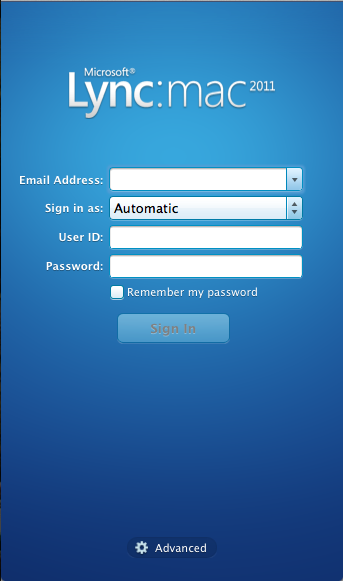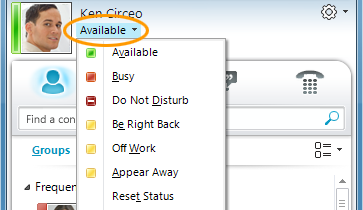

- #Microsoft lync for mac keeps changing status password#
- #Microsoft lync for mac keeps changing status windows#
MinValidityPeriodHours represents the minimum amount of time a client can request. When using certificate authentication, clients can request the period of time (in hours) that the certificate remains valid. MaxValidityPeriodHours can be any integer value between 8 hours and 8760 hours (365 days). MaxValidityPeriodHours represents the maximum amount of time a client can request. By default the Lync client requests a validity period using the minimum value (180 days) when a user signs into the client on a specific endpoint for the first time.įor more details on the certificate validity parameters see the Set-CsWebServiceConfiguration cmdlet documentation.
#Microsoft lync for mac keeps changing status password#
This cached client certificate on endpoints can be valid in Lync Server for between 6 to 12 months, which is typically much longer than most environment’s AD password expiration policies. This client certificate can be used for future authentication attempts against any Lync Server registrar (Front End, Director, Edge, SBA) and explains why the Lync client can still successfully sign-in even after a user’s AD account password has expired (or the account has even been disabled).

#Microsoft lync for mac keeps changing status windows#
Microsoft Lync 2010 Technology Explained: Īs the Windows Lync client supports both types of authentication what typically happens is that a user signs into the application using their Active Directory credentials for the first time and during this process the Lync Server will submit a client certificate to that user which the client application then stores in its local cache.It is more specifically known as TLS-DSK and for some background on what it is an how it works the following materials are recommended reading. But both NTLM and Certificate authentication methods are enabled and used by default for both the Windows Lync client and the Lync Phone Edition client.Īlthough NTLM authentication needs no introduction, this new-for-Lync certificate based method is still a mystery to many. There are currently three different types of authentication supported by Lync Server 2010: NTLM, Kerberos, and Certificate.īy default Kerberos is not completely functional throughout Lync Server as some additional configuration steps must be completed first. Lync supports a variety of different authentication methods and understanding which method is used, when, and why is important when troubleshooting any issues. Externally Provisioning Lync Phone Edition.Configuring Lync Server for Phone Edition Devices.It is suggested to review the following blog articles as some of the concepts in this article are explained in much more depth and thus a solid understanding of how the devices function can often be key to interpreting the observed behavior of the device. The following list of topics are discussed in this article.

It does not cover complete feature functionality but instead focuses on provisioning and operation of the client as well as some of the most common issues.Īdditionally the focus of this article is primarily on the Lync Phone Edition firmware which runs on the Aries family of devices (Polycom CX500/600/3000, Aastra 6721ip/6725ip, and HP/SNOM 4110ip/420ip) but also references the original Tanjay version (Polycom CX7000, LG-Nortel 8540) on a few occasions. This article serves as a follow-up to a few previous articles which will further explain some of the requirements, capabilities, and limitations of the Lync Phone Edition firmware which appear to still be unclear to some and seem to warrant further discussion.


 0 kommentar(er)
0 kommentar(er)
